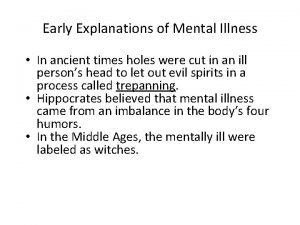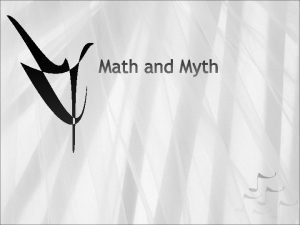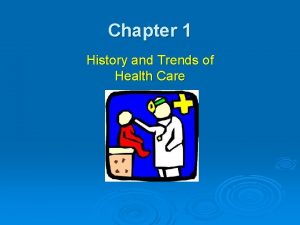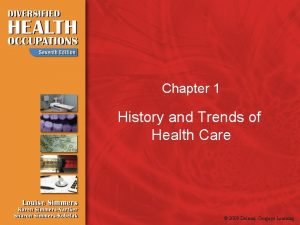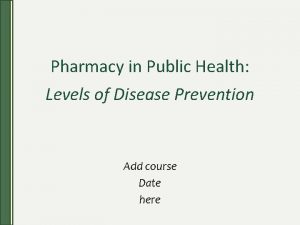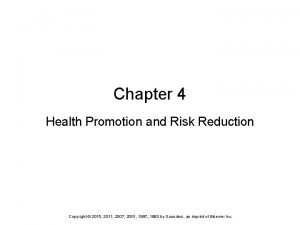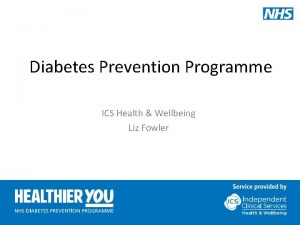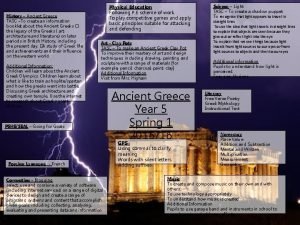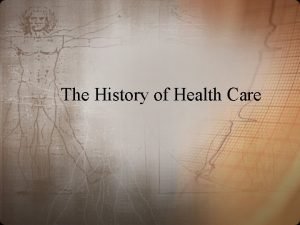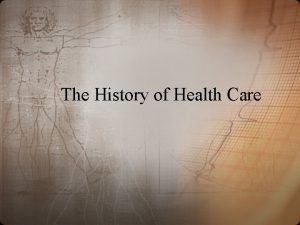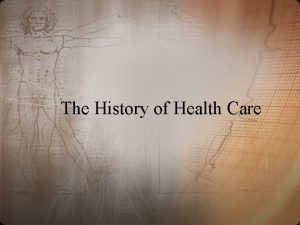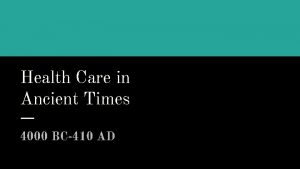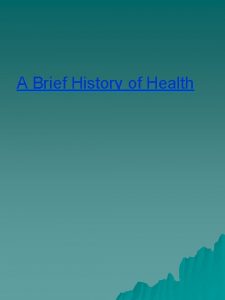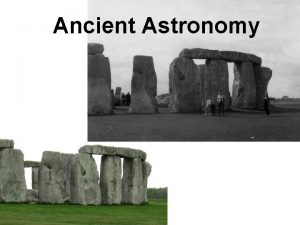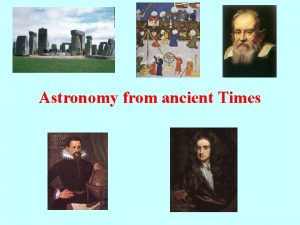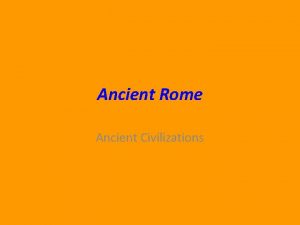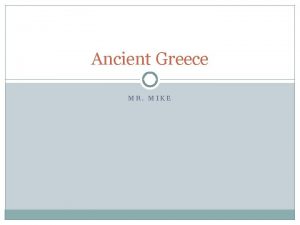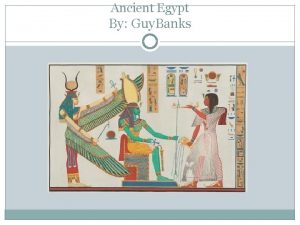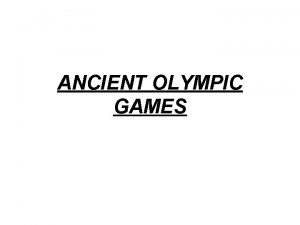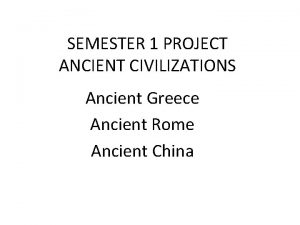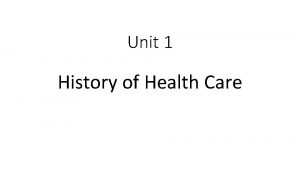The History of Health Care Ancient Times Prevention




































- Slides: 36

The History of Health Care

Ancient Times • Prevention of injury from predators • Illness/disease caused by supernatural spirits

Trepanning • Ancient skulls have been found with a hole bored into them - Believed the hole allowed evil spirits to leave the sick person

Ancient Times • Herbs and plants were used as medicine examples: – Digitalis from foxglove plants • Then, leaves were chewed to strengthen & slow heart • Now administered by pills, IV, or injections

Ancient Times • Quinine from bark of cinchona tree • Controls muscle spasms in gastrointestinal tract • Used to treat malaria

Ancient Times • Herbs and plants were used as medicine examples: – Atropine from belladonna and poisonous nightshade plants • Treat bradycardia – Morphine from opium poppy • relieves severe pain

Egyptians • Earliest to keep accurate health records • Superstitious-called upon gods for healing • Identified certain diseases

Egyptians • Priests were the doctors – Temples were places of worship, medical schools, and hospitals – Only the priests could read the medical knowledge from the god Thoth

Egyptians • Prescriptions were written on papyrus

Egyptians • Embalming – Done by special priests (NOT the doctor priests) – Advanced the knowledge of anatomy – Strong antiseptics used to prevent decay – Gauze similar to today’s surgical gauze

Egyptians • Research on mummies has revealed the existence of diseases – – – Arthritis Kidney stones Arteriosclerosis Obesity Diabetes Tooth decay

Egyptians • Some medical practices still used today – Enemas – Circumcision (4000 BC) preceded marriage – Closing wounds – Setting fractures – Surgical tools – Dental work

Egyptians • Eye of Horus – 5000 years ago – Magic eye – amulet to guard against disease, suffering, and evil – Evolved into modern day Rx sign

Jewish Medicine • Avoided medical practice • Concentrated on health rules concerning food, cleanliness, and quarantine • Moses: pre-Hippocratic medical practice – banned quackery (God was the only physician) – enforced Day of Rest

Greek Medicine • First to study causes of diseases • Research helped eliminate superstitions • Sanitary practices were associated with the spread of disease

Greek Medicine • Hippocrates (460 -375 BC) – no dissection, only observations – took careful notes of signs/symptoms of diseases – disease was not caused by supernatural forces • Father of Medicine – wrote standards of ethics which is the basis for today’s medical ethics

Greek Medicine • Asclepius – Created a serpent cult – People came from all over Europe – Caduceus-staff and serpent symbol of medicine

Roman Medicine • Learned from the Greeks and developed a sanitation system – Aqueducts and sewers – Public baths • Beginning of public health

Roman Medicine • First to organize medical care • Army medicine • Room in doctors’ house became first hospital • Public hygiene – flood control – solid construction of homes

Dark Ages (400 -800 A. D. ) and Middle Ages (800 -1400 A. D. ) • Medicine practiced only in convents and monasteries • custodial care • life and death in God’s hands

Dark Ages (400 -800 A. D. ) and Middle Ages (800 -1400 A. D. ) • Terrible epidemics – Bubonic plague (Black Death) – Small pox – Diphtheria – Syphilis – Measles – Typhonid fever – Tuberculosis

Dark Ages (400 – 800 A. D. ) and Middle Ages (800 -1400 A. D. ) • Crusaders spread disease • Cities became common • Special officers to deal with sanitary problems • Realization that diseases are contagious • Quarantine laws passed

Renaissance Medicine (1350 -1650 A. D. ) • Universities and medical schools for research • Dissection • Book publishing • Leonardo da Vinci – anatomy of the body

th 16 & th 17 • Anton van Leeuwekhoek (1676) – invented microscope – observed microorganisms Century

th 16 & th 17 Century • William Harvey – circulation of blood • Gabriele Fallopius – discovered fallopian tube • Bartholomew Eustachus – discovered the eustachian tube • Some quackery

th 18 • Edward Jenner 1796 – smallpox vaccination • Joseph Priestly – discovered oxygen Century

th 18 Century • Benjamin Franklin – invented bifocals – found that colds could be passed from person to person • Laennec – invented the stethoscope

th 19 & th 20 Century • Inez Semmelweiss – identified the cause of puerperal fever which led to the importance of hand washing • Louis Pasteur (1860 – 1895) – discovered that microorganisms cause disease (germ theory of communicable disease)

th 19 & th 20 Century • Joseph Lister – first doctor to use antiseptic during surgery • Ernest von Bergman – developed asepsis • Robert Koch – Father of Microbiology – identified germ causing TB

th 19 & th 20 • Wilhelm Roentgen – discovered X-rays • Paul Ehrlick – discovered effect of medicine on disease causing microorganisms • Anesthesia discovered – nitrous oxide, ether, chloroform Century

th 19 Century • Elizabeth Blackwell – First female physician in US

th 19 Century • Florence Nightingale – Founder of modern nursing

th 19 & th 20 Century • Alexander Fleming – discovered penicillin • Jonas Salk – discovered that a killed polio virus would cause immunity to polio • Alfred Sabin – discovered that a live virus provided more effective immunity

1900 to 1945 • Acute infectious diseases (diphtheria, TB, rheumatic fever) • No antibiotics, DDT for mosquitoes, rest for TB, water sanitation to help stop spread of typhoid fever, diphtheria vaccination • Hospitals were places to die • Most doctors were general practitioners

1945 to 1975 • • • Immunization common antibiotic cures safer surgery Transplants increased lifespan chronic degenerative diseases

1945 to 1975 • new health hazards – obesity – neuroses – lung cancer – hypertension – disintegrating families • greatly increasing medical costs
 Primary prevention secondary prevention tertiary prevention
Primary prevention secondary prevention tertiary prevention 15 times 15 times 20
15 times 15 times 20 Primary secondary and tertiary health care
Primary secondary and tertiary health care Health and social care values unit 2
Health and social care values unit 2 Since ancient times nature
Since ancient times nature Mental illness in ancient times
Mental illness in ancient times Ancient means of communication pictures
Ancient means of communication pictures Uses of wedge
Uses of wedge Ever since ancient times
Ever since ancient times I graffiti
I graffiti Chechen
Chechen Chapter 1 history and trends of healthcare
Chapter 1 history and trends of healthcare Chapter 1 history and trends of healthcare
Chapter 1 history and trends of healthcare Health and social care component 3 health and wellbeing
Health and social care component 3 health and wellbeing Workwell prevention & care
Workwell prevention & care Ancient india vs ancient china
Ancient india vs ancient china Health promotion and levels of disease prevention
Health promotion and levels of disease prevention Health promotion and levels of disease prevention
Health promotion and levels of disease prevention Ics health and wellbeing diabetes prevention programme
Ics health and wellbeing diabetes prevention programme History of theatre ancient rome
History of theatre ancient rome History alive chapter 8
History alive chapter 8 History alive chapter 14
History alive chapter 14 Medieval netherlands
Medieval netherlands Tasc ancient history
Tasc ancient history From hunters and gatherers to farmers chapter 3
From hunters and gatherers to farmers chapter 3 Punjab physical features
Punjab physical features Ancient greek theatre history
Ancient greek theatre history Ancient desert clothing
Ancient desert clothing World history jeopardy
World history jeopardy World history ancient civilizations through the renaissance
World history ancient civilizations through the renaissance Hát kết hợp bộ gõ cơ thể
Hát kết hợp bộ gõ cơ thể Lp html
Lp html Bổ thể
Bổ thể Tỉ lệ cơ thể trẻ em
Tỉ lệ cơ thể trẻ em Voi kéo gỗ như thế nào
Voi kéo gỗ như thế nào Chụp phim tư thế worms-breton
Chụp phim tư thế worms-breton Alleluia hat len nguoi oi
Alleluia hat len nguoi oi





